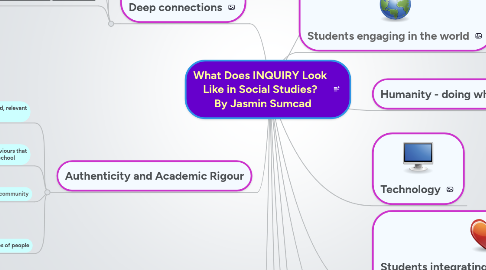What Does INQUIRY Look Like in Social Studies? By Jasmin Sumcad
da Jasmin Sumcad

1. Authenticity and Academic Rigour
1.1. Engaging in work rooted in real-world, relevant questions, controversies, and issues
1.1.1. Real-world issues
1.2. Students working in ways or behviours that mirror the disciplines outside of school
1.2.1. History – how to historians think, act, work, and produce knowledge?
1.3. Students taking part in the community
1.3.1. Involved in community issues, political events, forums, using technology to broadcast forums, encouraging others to vote in elections, advocating for democratic practices (voting), active citizenship, becoming passionate about issues
1.4. Connecting with different groups of people
1.4.1. discovering values and worldviews of another country
1.4.1.1. representing understandings visually/digitally
1.4.2. realize how difficult it is actually understand another culture… their assumptions may be totally right, or totally wrong
1.4.2.1. Changing ways of thinking, re-thinking assumptions
2. Kids learning how to think and behave in the ways of a discipline
2.1. Discipline
2.2. Not just learning about SS, but learning how to use SS-focused (historical, geographical, creative, critical, problem-solving and decision-making, metacognitive) thinking
2.3. Thinking from different perspectives (i.e. Acadian, Francophone, Aboriginal, etc.)
2.3.1. Multiple Persepectives
2.4. Acting like historians, geographers, or people of the past
2.5. Discipline
3. Connecting the classroom to world issues and current events
3.1. Classroom
3.2. World
4. Deep connections
4.1. Moves beyond "activity mania"
4.2. students are given some "buy-in" into the material they are learning/engaged in
4.3. http://web.mit.edu/newsoffice/2011/illuminating-brain-0128.html
5. Benchmarks of Historical Thinking
5.1. Establish Historical Significance
5.2. Use Primary Source Evidence
5.3. Identify Continuity and Change
5.4. Analyze Cause and Consequence
5.5. Take Historical Perspectives
5.6. Understand Ethical Dimensions of History
5.7. http://andrewdsmith.wordpress.com/2009/12/07/canadian-historians-and-climate-change/
6. Students engaging in the world
7. Humanity - doing what it is to be HUMAN
7.1. involved in the real world, understanding human connections
7.2. Humanity
8. Students integrating what they love/enjoy into what they are learning
9. Analyzing from multiple perspectives
9.1. Historical people - diary entries, how events would affect their communities
9.2. Creating propaganda posters, identifying events that would support a historical figure or group's perspective
10. Technology
11. Throughline Thinking
11.1. Teachers asking relevant and provocative questions to make connections between the 3 S’s: Self, Subject matter, and the Society in which they live
11.2. Interaction with experts - students facilitate questioning
11.3. Students redesigning, re-imagining, and recreating something
11.4. http://www.maggiehosmcgrane.com/2010/10/what-does-inquiry-look-like.html
12. Critical or Dangerous Teaching
12.1. teaching that engages students in the often-unasked questions about the “what and how” students learn in school
12.2. getting students to critique society (institutions of school)
12.3. kids bringing about change, students who are empowered


